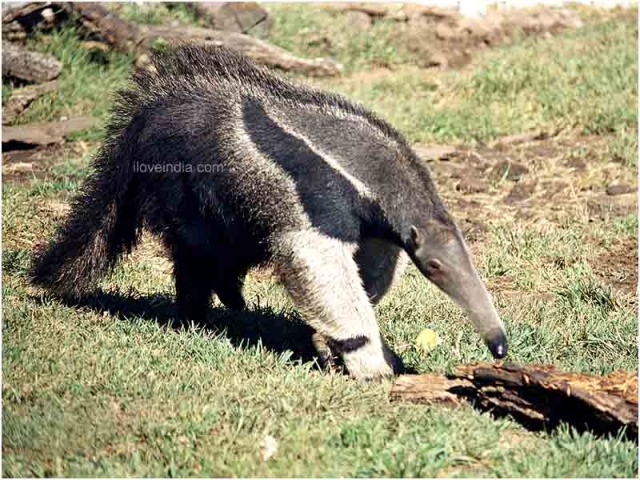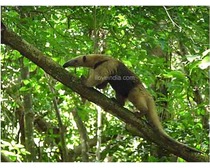‘Anteaters’ are mostly found in the central and southern zones of America. Read on to know some very interesting facts and amazing information on Giant Anteaters.
Facts About Anteater
‘Anteaters’ is the term used to refer to the four mammal species of the suborder Vermilingua. All the four species under this category eat ants and termites. Along with sloths, anteaters make up the order Pilosa. The term "anteater" is also colloquially applied to aardvark, numbat, echidna, and pangolin, though they are not at all related to the four species of anteaters. These animals are edentate (lack teeth) and use their long tongues for the purpose of swallowing ants and termites. Anteaters have to eat quickly, using an average of about 160 flicking movements of their tongue per minute. This has to be done to avoid the painful stings of the ants fighting back. This species of animals is found mostly in the central and southern zones of America. To know more about this unique animal, go through the interesting facts and amazing informationgiven below.

Facts About Anteater
Binomial Name: Syncerus caffer
Kingdom: Animalia
Phylum: Chordata
Class: Mammalia
Superorder: Xenarthra
Order: Pilosa
Suborder: Vermilingua
Family: Myrmecophagidae
Genus: Myrmecophaga
Species: Myrmecophaga tridactyla
Body Length: 14 inches to 6 feet (35 cm to 1.8 m)
Tail Length: 650 to 900 mm
Weight: 18 to 39 kg
Life Span: 25 years (in captivity)
Diet: Ants, termites, soft bodied grubs, fruits and eggs.
Range: Central to South America
Habitat: Grasslands, deciduous forests, rain forests, savannas, wet forests & swamps.
Age of Maturity: 2.50 to 4 years
Gestation Period: 190 days (approximately)
Number of Offspring: One
Interesting & Amazing Information On Anteaters
- Giant Anteater (Myrmecophaga tridactyla) represents the largest species of anteaters in this world. It is a solitary mammal that is mostly found in habitats like grasslands, deciduous forests and rainforests.
- Anteaters are devoid of teeth. Instead they use their tongue to gather insects for food. Their tongue can reach up to a maximum of 2 feet in length and is relatively narrow over the entirety of its length.
- The tongue of anteaters is coated with a thick, sticky layer of saliva, which enables them to catch hold of their prey. Also, their tongue has tiny spines that point towards the back of the throat.
- Giant anteaters can eat up to a maximum of 30,000 insects per day. In order to aid the process of digestion, the stomach of all anteaters secretes formic acid, instead of the normal hydrochloric acid.
- Giant anteaters tend to pursue the larger bodied social insects, while the tamanduas and silky anteaters feed on smaller insects. Such differentiation in their dietary habits enables them to co-exist in the same habitat, without competing for their prey.
- Anteaters sleep for a total of about 15 hours per day.
- Due to their food habit and lifestyle, anteaters have very low metabolic rates. The Giant variety has the lowest recorded body temperature of any placental mammal (90.9°F).
- Anteaters have a powerful olfactory system (40 times that of man) and can easily detect their prey using their strong sense of smell.
- When anteaters feel threatened, they produce a typical bellowing noise. Occasionally, they also rear up on their hind quarters and swipe with their long fore-claws.
- Anteaters have a typical pattern of walking, by flexing their digits upwards and turning their forefeet inwards. They do not use the normal process of walking on the soles of their forefeet.
- Unlike the other varieties of anteaters, Giant anteaters are terrestrial in nature and rarely climb trees.


See also
More from iloveindia.com
- Home Remedies | Ayurveda | Vastu | Yoga | Feng Shui | Tattoos | Fitness | Garden | Nutrition | Parenting | Bikes | Cars | Baby Care | Indian Weddings | Festivals | Party ideas | Horoscope 2015 | Pets | Finance | Figures of Speech | Hotels in India : Delhi | Hyderabad | Chennai | Mumbai | Kolkata | Bangalore | Ahmedabad | Jaipur
- Contact Us Careers Disclaimer Privacy Policy Advertise With Us Lifestyle Sitemap Copyright iloveindia.com. All Rights Reserved.




